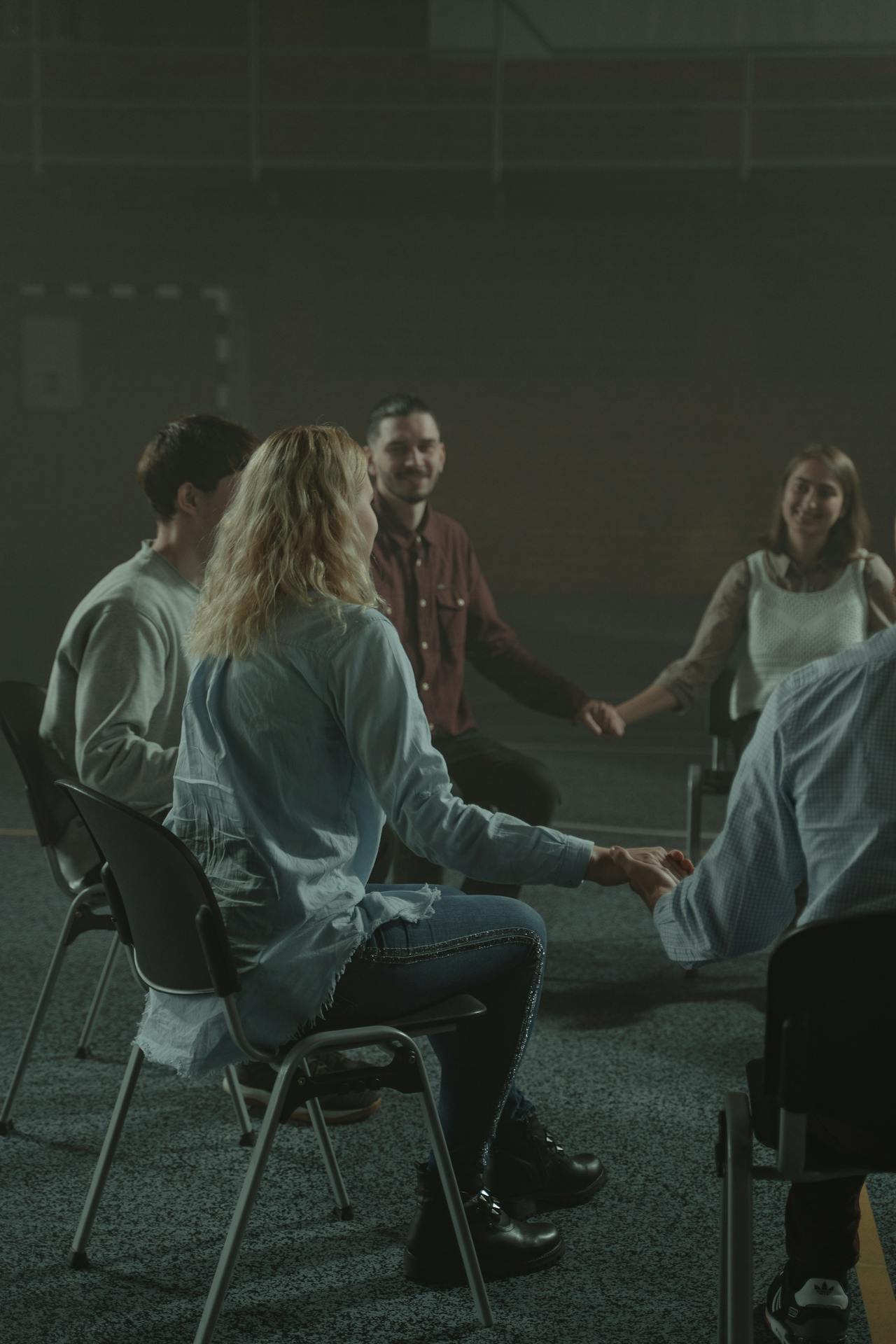cPTSD | Thunderbolts* | Mental Health & Pop Culture
As a psychologist who often works with trauma – and as a geek who loves movies and other media – I enjoy looking to pop culture for stories of resilience and healing. Many of my clients have developed a deeper, more compassionate understanding of their own experiences by exploring parallels to their favorite fictional character’s story.
As I watched Marvel’s Thunderbolts*, I was drawn in by the poignant depictions of how each character’s trauma background had the potential to either hold them back or empower them. Specifically, the Thunderbolts display many of the hallmark symptoms of Complex Post Traumatic Stress Disorder (cPTSD). Today I invite you to learn about what cPTSD looks like using examples from this film. (Spoilers ahead!)
What is cPTSD?
You’ve probably heard of Post Traumatic Stress Disorder (PTSD) – a common mental health experience that can develop after a traumatic experience such as an assault, accident, or near-death experience. Our modern understanding of PTSD began with observing “shell shocked” veterans returning from World War I.

Over time, researchers have recognized that a variety of events can be traumatic and impact our mental health in similar ways.
Unfortunately, our understanding of trauma (and how to treat it) has been limited by a focus on a singular traumatic event. In reality many people experience prolonged or repeated traumatic events such as chronic childhood abuse or neglect, bullying and rejection by peers, intimate partner violence (IPV), human trafficking, or exposure to human suffering as a frontline worker.
Prolonged trauma can impact our development, relationships, and physical and mental health in profound and complex ways. Though psychiatrist Judith Herman first identified “complex PTSD” in 1992, it has been slow to gain recognition. cPTSD wasn’t recognized as a diagnosis by the World Health Organization (WHO) until 2019, and it still isn’t part of the American Psychiatric Association’s diagnostic manual – the DSM-V.
“There’s something wrong with me – an emptiness…”
“There’s something wrong with me – an emptiness… I thought it started when my sister died, but now it seems like something bigger. Just a – void…
I thought throwing myself into work was the answer, but I’m not focused, and I’m not happy, and I have no purpose. It’s not that I lack purpose; I’m just drifting like a river. Or like an old leaf. Or like an old leaf on a river. Which do you think is better?”
– Yelena
The Thunderbolts are a group of “anti-establishment fighters-heroes” that begrudgingly bands together to protect New York City from the latest threat – Sentry. The Thunderbolts’ journey involves facing their individual trauma histories in order to “bring light from darkness” that has enveloped their sense of self over time. In this blog, we will focus on the stories of two Thunderbolts – Yelena Belova and Robert “Bob” Reynolds.
“You’ve always thought of yourself as a victim, but you overcame that…
Robert, I know everything about you, and I still want you to be my guy.
And isn’t that what you want? To be accepted? Embraced? To be chosen?
Nobody else sees it – but I do.
And I believe that maybe your past is what makes you so perfect…?”
– CIA Director to Bob
When Bob hesitates to become the “Golden Guardian of Good,” the CIA Director – Valentina “Val” Allegra de Fontaine – uses her knowledge of his childhood trauma to convince him to work for her. She responds to Sentry’s desire to collaborate rather than be controlled by triggering the kill-switch inside him. Doing so transforms him into The Void, an embodiment of the depths of depression.
Unlike his counterpart draped in golden regalia, Void is an opaque, shadowy figure who turns his victims into wisps of darkness, transporting them to pocket dimensions (“shame rooms”) where they have to re-live their most distressing memories. The film focuses on the Thunderbolts, particularly Yelena, rescuing Bob from his own pocket dimension in order to defeat the Void and save New York City.
A Deep Dive into cPTSD
Negative View of Self: Shame, Guilt, & Failure
Individuals experiencing cPTSD tend to judge themselves quite harshly – often because they have adopted the critical voice that the perpetrator(s) of their trauma used as a form of control. Over time they may view themselves as unworthy of love or joy which can result in hopelessness about the future and even suicidal thoughts.
As Yelena and her colleagues figure out how to escape from O.X.E.’s covert facility, we are introduced to Bob’s negative sense of self and belief that “everyone’s better off if [he] just stay[s] put,” though it means that he will die when the facility blows up. Yelena commiserates with him stating that “we all feel like sh*t sometimes” and relating to his sense of isolation. They realize that they both experience “a void” – a darkness that becomes “pretty enticing.” When Yelena jokingly encourages him to “shove it way down,” Bob’s experience of feeling truly seen convinces him to escape with her.
Individuals with cPTSD may interpret personal mistakes as confirmation that they are “not good enough” and struggle to center the compassion that they would offer to others. This negative sense of self can be so encompassing that any compliments or encouraging words from a friend or colleague are written off as lies coming from a place of pity.
After Sentry overpowers the Thunderbolts, Yelena tearfully tells her adoptive father Alexei that she’s constantly plagued by regret about “all the terrible things” she did in her prior life as a Black Widow assassin, which she copes with by abusing alcohol. Alexei gently points out that she was forced to lead that life since childhood. He validates the darkness of those times and highlights the brightness and joy Yelena experienced before that chapter of her life. Alexei reminds her that she wanted to be the goalie of her “terrible soccer team” – the namesake of the Thunderbolts – because she wanted to be “the one everyone can rely on if they make a mistake.” Yelena softens when he shares that he sees that version of her when he looks at her rather than her missteps, highlighting that they need each other.
Hypervigilance
Throughout the film, we observe the tactical prowess of each Thunderbolt. One could argue that their complex trauma backgrounds prime them to be highly intuitive and adept at combat. How so?
Hypervigilance, a hallmark of cPTSD, sharpens one’s ability to detect potential threats in the environment with the aim of protecting oneself from harm. While some individuals experience a freeze response, others react by springing into action or fleeing. Despite being an advantage for the Thunderbolts, many individuals find that hypervigilance contributes to a heightened startle response that can cause challenges in personal and professional settings.
Difficulty with Emotion Regulation, Attention, & Memory
Many individuals with cPTSD have experienced prolonged exposure to people with unpredictable emotional reactions and environments that didn’t consistently meet their needs.
They likely haven’t been taught or shown how to properly regulate their emotions which often leads to emotional volatility or suppression that eventually reaches a tipping point.
Prior to Director Val officially recruiting Bob to protect the world as Sentry, “Earth’s mightiest hero,” her assistant expresses concern about whether Bob is stable enough to take on this responsibility. She discloses that his medical file from Project Sentry described him as having “delusions of grandeur” and depressive episodes that will likely be amplified by his newfound superpowers. The trial participants were only meant to be test subjects – not “the one.” We see an example of Sentry’s inflated sense of self after he disobeys Val’s order to eliminate the Thunderbolts. He questions Val asking “why would a god take orders from anyone at all?” After accusing her of not knowing what he is capable of, Sentry strangles Val and slams her into a wall until her assistant triggers Sentry’s kill-switch.
The average memory is stored in the hippocampus which converts short-term memory into long-term memory, allowing you to store and retrieve that information. On the other hand, the amygdala – responsible for emotional processing – plays a role in storing memories involving high emotional arousal (e.g. fear, trauma). The brain’s use of these alternative neural pathways contributes to recalling memories in a fragmented manner that emphasizes sensory elements (e.g. sights, sounds, smells) rather than a cohesive narrative.
Once he has built a certain level of trust with Yelena, Bob discloses that he has experienced “episodes” since childhood during which he experiences a “high” that makes him feel “invincible” and a “low” that reminds him that “nothing matters.” These events conclude with Bob having no memory of what happened during that period of time, which does indeed occur at the end of the film.
Vivid Re-Experiencing of Traumatic Memories
While going through their day, individuals with cPTSD find that memories of their trauma pop up unexpectedly. This re-experiencing can be triggered by cues in the environment that somehow parallel their traumatic experiences.
For example, they may interact with a hot-headed manager who unconsciously reminds them of a parent, or they may witness bullying when picking their child up from school. Traumatic memories can even show up in your dreams.
When Yelena finds Bob in his “nicest” shame room, she witnesses one of his childhood memories in which his father verbally and physically abuses his mother. Young Bob tries to intervene, telling his father “don’t touch her.” His mother tells him to “shut [his] mouth” because he “always made it worse,” while his father taunts him: ”You a hero, Bobby?”
Earlier in the film when the Thunderbolts get stuck in an elevator shaft due to Bob’s escape plan not being fully developed, we see a subtle example of Bob being instantly brought back to that memory.

In response to John Walker sarcastically chastising him, saying “great plan, Bobby,” Bob quietly tells himself that he’s “always making things worse.” It is clear that Bob’s sense of self has been deeply damaged by his childhood experiences.
Avoidance of Trauma Reminders
Given that traumatic memories can surface unexpectedly, individuals with cPTSD often try to foster a sense of control by staying away from cues in their environment or situations that may elicit a flashback. This type of avoidance can contribute to social isolation and experiencing life in a way that is disconnected from one’s thoughts, feelings, and memories. In some cases, these individuals may experience dissociative episodes during which they feel detached from reality.
Chronic avoidance can keep us from being our most authentic selves and leading a life aligned with our values.
Soon after James “Bucky” Barnes saves and then captures the Thunderbolts with the intent to turn them in to the US government, he receives a call from Director Val’s assistant who pleads with him to come deal with Sentry and Val who “has gone off the rails.” Though initially hesitant, Bucky realizes that he needs to band together with the Thunderbolts to stop this dangerous duo. While Alexei views them as a team that can “rise to glory” and “bring light from darkness,” Yelena hastily rejects the idea telling Bucky that he has chosen “the wrong people.” Understanding her hesitation given his own past trauma, he frames this opportunity as a path forward for all of them.
Look, I’ve been where you are. You can run, but it won’t get you far.
Sooner or later, it’ll catch up to you, and when it does it’ll be too late.
So you can either do something about it now or live with it forever.
– James “Bucky” Barnes

Difficulty Maintaining Relationships & Feeling Close to Others
As a form of self-protection, individuals who have experienced complex trauma have difficulty trusting others in part because their trauma taught them that they can only rely on themselves.
They form insecure attachments to others that manifest in a variety of ways.
Some individuals may be hyper-independent – not asking for help even when it will negatively impact them – and prioritize other aspects of their life such as work or hobbies. Others may experience a push-pull that causes them to alternate between getting close to others and withdrawing from them.
After being defeated by Sentry at the Watchtower, the Thunderbolts disperse as Yelena asserts a painful belief: “you’re not a hero; you’re not even a good person.”
When Alexei follows Yelena and tells her that he’s checking on her “because that’s what family does,” she accuses him of not truly caring for her given that he did not reach out to her for a year after her sister Natasha died. Alexei pauses to consider her words.
Alexei: I’m sorry. I don’t know how to do this.
I’m not good at it. I didn’t think you wanted me.
Yelena: I did.
Alexei: I see that. I’m late, but I’m… I’m here now.
Since having a complex trauma history can also contribute to self-doubt and feelings of worthlessness, individuals may fear abandonment and decide that it’s more psychologically and emotionally safe for them to socially isolate themselves. They may achieve that by sticking to surface-level connections and not allowing themselves to form deeper, vulnerable relationships.
At the end of the film when Bob pleads with Void to let his friends go, the shadowy figure mocks him stating that the Thunderbolts do not care about him – “You don’t matter – to anyone.” Void shames Bob for believing that he could be “anything more than… nothing.”
You thought you were gonna be some great man?
Some savior? You can’t even save yourself.
We… will always… be alone.
– Void
Somatic Symptoms
As explained in psychiatrist Bessel van der Kolk’s book entitled The Body Keeps the Score, emotional pain can manifest in a physical way especially if we suppress our feelings or don’t address the underlying trauma. In fact, it is common for individuals to go to their primary care provider to address pain or fatigue and be referred to therapy to explore the potential psychological causes.

Until the other Thunderbolts come to their rescue, Bob and Yelena must defend themselves from a physical manifestation of their emotional torment in Bob’s shame room. Turbulent winds cause everything in the shame room to whirl around them in a tornado-like fashion. The duo is struck by a flying table and chairs before being choked by a window curtain. One can view this chaos as a metaphor for chronic anxiety and depression that often accompanies cPTSD.
Some of my clients are still actively experiencing complex trauma. For example, they may not yet be able to leave their toxic work environment, or they may be living with the perpetrators of their trauma, such as their parents, while they save up enough money to move out. As they continue to navigate waves of emotion related to their trauma, clients have reported experiencing ailments such as high blood pressure, migraines, muscle tension, and chronic illnesses like fibromyalgia.
In the film’s climactic scene, the Thunderbolts find themselves in the lab where Bob participated in the Project Sentry medical trial. The Void uses his telekinetic powers to incapacitate everyone except for Bob, pinning them to a far wall using large pieces of metal found around the lab.
Void: [mockingly] Robert – the hero.
Bob: I’m stronger than you.
Void: Let’s see.
After a brief scuffle, Bob knocks the Void down and proceeds to punch him repeatedly, causing the shame room to start collapsing. We see the Void’s dark energy slowly consume Bob starting at his feet. Yelena manages to break free from her restraints and rushes toward Bob just as the darkness envelops his neck, embracing him in a hug from behind – “I’m here. You’re not alone.” The other Thunderbolts follow suit and restrain him with a group hug that compels Bob to stop attacking the Void and allow himself to cry. As the Void vanishes, the Thunderbolts find themselves back in New York City where Director Val unexpectedly introduces them to a crowd of reporters as the New Avengers.
Resilience After Complex Trauma

Yelena: What I said to you before was wrong, Bob.
You can’t stuff it down.
You can’t hold it in all alone – no one can.
We have to let it out.
We have to spend time together.
And even if it doesn’t make the void go away – I promise you it will feel lighter.
Bob: How do you know?
Yelena: Because it already has for me.
We can find a way out of here together.
Will you try and leave here with me?
[Bob tearfully nods.]
Interpersonal connection stands out as a core theme throughout the film. As described by Director Val early in the story, she considers the members of the Thunderbolts to be “antisocial tragedy in human form.”
As described by Director Val early in the story, she considers the members of the Thunderbolts to be “antisocial tragedy in human form.” She even expresses that she “can’t think of a worse group of people trying to work together,” given their history of acting in volatile ways. When they initially confront her at the Watchtower, Val downplays their efforts calling them “adorable.”
Though initially guarded and suspicious of each other, the Thunderbolts gradually build trust through consistent interactions. Moments of intense frustration and shame are met with compassion and reassurance. They are each truly seen – perhaps for the first time – and develop the ability to view themselves through the kinder eyes of their fellow Thunderbolts.
About the Author
Dr. Alexis López is a licensed clinical psychologist and Stella Nova’s Director of Clinical Operations. Alexis specializes in supporting women of color and adult children of immigrants to manage stress, anxiety, and the pressures of navigating multiple cultures at once. A self-professed “geek”, Alexis loves looking at stories and characters through the lens of mental health, and often brings a shared love of games, books, and movies to her work with clients.
If you’d like to learn more about working with Dr. López or any of the therapists at Stella Nova, you can schedule a free, 20-minute consultation to get started.
Subscribe To Our Newsletter
Want more valuable mental health content? Keep in touch with Stella Nova by subscribing to our mental health newsletter. We share valuable tips and information twice a month, as well as periodic practice updates, upcoming events, and discounts.
When you sign up, you’ll also receive a copy of our free Preparing for Therapy mini-workbook to help you get ready to get the most out of your experience.


